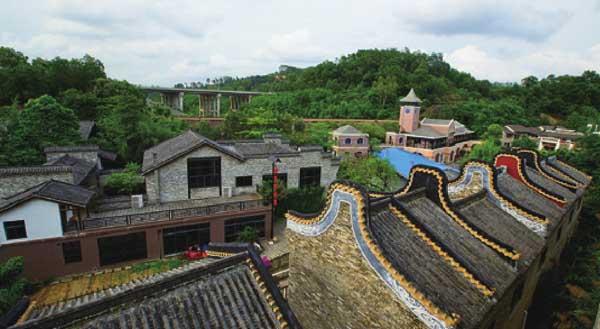Rejuvenating Folk Culture
2016-05-14ByLiNan
By Li Nan

A statue of the Liangmao Baby, an eth-nic Hakka girl wearing a liangmao, or cool hat, was erected on September 29 in the Gankeng New Town, located in Longgang District of Shenzhen in south Chinas Guangdong Province. The cool hat is a traditional bamboo hat worn by local women when working in the fields.
The Liangmao Baby is the new mascot of the Gankeng New Town, which is now being transformed into a resort and cultural innovation hub after receiving an investment of 50 billion yuan ($7.57 billion).
The operation is a public-private partnership (PPP) project, founded in May 2016 through the collaboration of the Shenzhenbased Overseas Chinese Town (OCT) Group, the Longgang District Government, the Shenzhen Gankeng Ecological-Culture Development Co. Ltd. and Gankeng JointStock Company. The OCT Group is a stateowned conglomerate focusing on tourism, real estate and electronic products.
Situated next to Chinese telecom equipment giant Huaweis headquarters, the Gankeng New Town has a planning area of 12 square km, consisting of several Hakka villages.
The original Gankeng Town has a 350-year history dating back to the Qing Dynasty(1644-1911). It has long been home to Hakka people, one of the eight subgroups of the Han Chinese.
The town was the biggest production base for cool hats after the founding of the Peoples Republic of China in 1949. At that time, every household produced bamboo hats, which were then exported to Southeast Asia, Britain and France.
However, in the late 1970s the hat lost its market appeal due to the shift in customer tastes for accessories and the popularization of air conditioners, Hu Meilin, General Manager of Shenzhen OCT Cultural Holding Co. Ltd., told Beijing Review. Demand shrank and the hat-making industry in the town declined. After the last Hakka hat maker died in 2002, residents in the town of Gankeng made no more hats.
Preserving local features
In 2013, the Hakka hat-making craft was added to Guangdongs provincial intangible cultural heritage list.
The OCT Group has vowed to work with the local government and residents to transform the old town into the countrys “first Hakka culture theme town” by integrating new technologies and ideas with the traditional tourism industry.
Further renovations are planned in the coming years. The genes of traditional Hakka culture, local history, and original scenery will be preserved, according to Hu, who is in charge of the project.
“The cool hat is a typical symbol of Hakka culture,” said Hu. Bamboo hat workshops are to be set up to inherit and improve the old crafts. Cartoons, films, picture books and dramas themed on the Liangmao Baby will be produced in the coming years, added Hu.
Since peanuts are a traditional snack of Hakka people, a farm featuring peanut planting and processing will be built. “We are striving to revitalize the charm of farming by showing visitors how food comes out from the soil,” Hu told Beijing Review.
Hakka herbal bathing will also be promoted, since it is a popular way to deal with Guangdongs hot and humid weather. Bathing in the herbal water also helps prevent the occurrence of heat rashes.
F u r t h e r m o r e , Hakka-styled residential houses are to be turned into museums, performance centers, shops, wedding halls, restaurants, and homestay accommodations. In addition, a series of events such as an international hat culture week and a Hakka food festival will be held to promote traditional Hakka culture.
New technologies
Modern technologies including virtual reality(VR) and augmented reality are planned to be used to present and preserve Hakka culture.“Technology has brought significant changes to Chinas cultural industry. We should adopt a ‘culture plus technology model when we develop a modern cultural industry so that it can achieve greater growth,” said Hu.
The Gankeng New Town is expected to become a place where traditional culture meets emerging industries, said Hu. Its more than a Hakka tourist resort. It aims to be an incubation center for cultural startups and VR technology development.
VR film and television production centers as well as a VR sport park will be set up in the town. A VR theater where visitors can learn about the history of Hakka culture and a post office featur-ing VR postcards are also expected to be built.
Chinas first VR cartoon film about the Liangmao Baby and Hakka culture will be produced by Shenzhen OCT Vision Inc., a subsidiary of the OCT Group. VR racing, marathon and fighting competitions are to be held in the coming years.
“The Gankeng New Town cannot be cloned,” Guo Yun, a researcher with the Chinese Academy of Social Sciences, told Beijing Review. He made the comment when asked about the difference between the OCT Groups Gankeng New Town and Wandas Han show. The latter is a recent project funded by the Dalian Wanda Group, another leading entertainment player in China. The show celebrates the essence of Han culture by integrating drama, acrobatics, synchronized swimming and diving with the help of high-end stage equipment.
The Gankeng New Town aims to attract 5 million tourists annually after the construction is completed in five to eight years, according to OCT Group.
One hundred towns
The Gankeng New Town is part of the OCT Groups ambition to develop 100 towns showcasing different local cultures throughout the country, said Wang Xiaowen, President of the Shenzhen OCT Co. Ltd. Wang was speaking at the 2016 Anren Forum held by the Counselors Office of the State Council and the Chinese Culture Promotion Society in southwest Chinas Sichuan Province in May.
“Cultural tourism has significant implications for improving public services in towns and increasing the value of land,” said Wang. As a leading tourism and real estate company, the OCT Group has sought to capitalize on the cultural tourism industry during Chinas rapid urbanization process.
According to Chinas new type of urbanization plan rolled out in March 2014, the country aims to increase its urbanization rate to 70 percent and its urban population to 1 billion by 2030.
“We should avoid destroying cultures while pursuing urbanization. In particular, as we renovate old towns, traditional cultural relics and customs should be preserved,” said Chen Yajun, an official with the National Development and Reform Commission.
“The OCT Groups business model is rooted in the local reality and differs from others, which is expected to usher in a ‘culture plus new urbanization trend in China,” said Wang.
The OCT Group will retain every towns original features including the local history, culture and environment when developing the 100 towns, added Wang.
Wang said that the 100 towns are expected to provide 200,000 jobs.
“So far, the OCT Group has inked deals with local governments in Sichuan, Yunnan, Guangdong, Hainan and Shanxi provinces, and invested in nearly 20 scenic spots and cultural tourism towns,” Guan Shan, Assistant President of the Shenzhen OCT Co. Ltd., told Beijing Review.
But Hu also admitted that the OCT Group is looking for answers to questions regarding the construction of cultural tourism towns. One of the problems is how to create market appeal for traditional cultural products. Without modern and funny designs, its hard to commercialize these products, said Hu.
Moreover, its critical to find effective ways to make profits and keep the capital chain stable, said Guo. “If cash flow problems occur, the Gankeng New Town and other towns may become unsustainable.”
Clarifying the property rights among the parties involved is another headache. Governmental regulations are needed to address the issue, Hu told Beijing Review.
